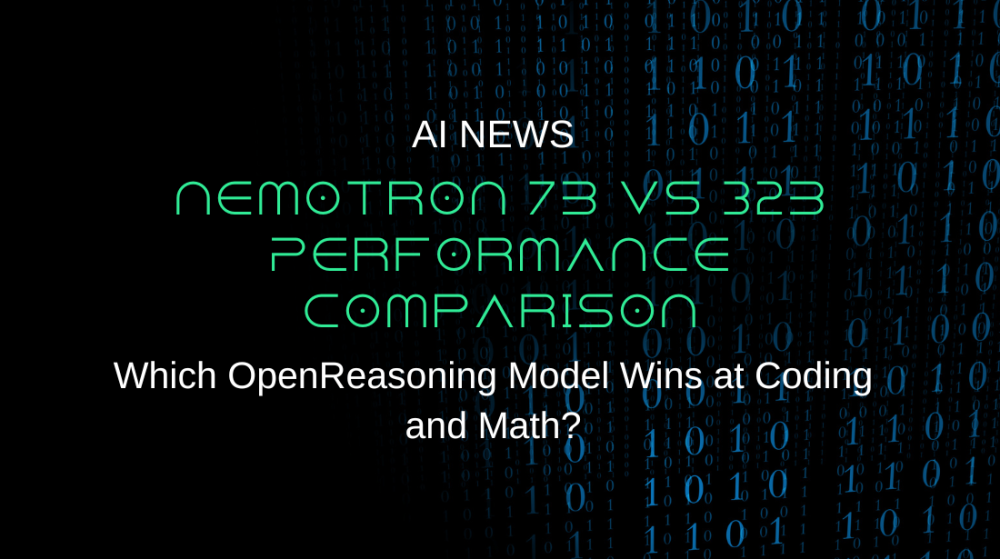Nemotron 7B vs 32B Performance Comparison: Which OpenReasoning Model Wins at Coding and Math?
A new suite of AI models called OpenReasoning-Nemotron is challenging the notion that bigger is always better in artificial intelligence, achieving state-of-the-art reasoning performance while using significantly fewer computational resources than competing systems.
Released this week, the OpenReasoning-Nemotron family includes four models ranging from 1.5 billion to 32 billion parameters—dramatically smaller than the 671-billion-parameter DeepSeek R1 model they were trained from. Despite their compact size, these specialized problem-solvers are setting new benchmarks in mathematics, science, and coding challenges.
OpenReasoning-Nemotron Performance
Discover how smaller AI models deliver breakthrough reasoning performance across challenging benchmarks
What Makes These Models Different
The OpenReasoning-Nemotron models were created through a process called "distillation," where researchers generated 5 million high-quality reasoning solutions using the massive DeepSeek R1 0528 model. The smaller models then learned from these examples, absorbing the reasoning capabilities without requiring the same computational resources as their teacher.
Unlike many recent AI developments that rely on reinforcement learning techniques, these models were trained using only supervised fine-tuning. This approach was deliberately chosen to provide researchers with a strong foundation for further experimentation with reasoning-based AI techniques.
Impressive Benchmark Performance
The models demonstrate exceptional performance across challenging reasoning benchmarks:
Key Results (Pass@1 scores):
- 7B model: 84.7% on AIME24, 71.9% on MMLU-PRO, 63.3% on LiveCodeBench
- 14B model: 87.8% on AIME24, 77.5% on MMLU-PRO, 67.8% on LiveCodeBench
- 32B model: 89.2% on AIME24, 80.0% on MMLU-PRO, 70.2% on LiveCodeBench
These scores represent new state-of-the-art performance for models in their respective size categories, particularly impressive given their compact nature compared to larger commercial systems.
GenSelect: The Secret Weapon
The researchers introduced an advanced inference mode called "GenSelect," where multiple parallel generations work together to solve problems. In this mode, the system generates multiple solutions and uses AI-powered selection to choose the best answer.
When using GenSelect, the 32B model approaches and sometimes exceeds the performance of OpenAI's o3 system on mathematics and coding benchmarks. Remarkably, while the selection capability was only trained on math problems, it successfully generalized to coding challenges as well.
GenSelect Performance Highlights:
- AIME24: 93.3% (up from 89.2% single-pass)
- HMMT Feb 25: 96.7% (up from 73.8% single-pass)
- LiveCodeBench: 75.3% (up from 70.2% single-pass)
Democratizing AI Research
The release addresses a significant barrier in AI reasoning research. Previously, working with cutting-edge reasoning models required substantial computational resources only available to major tech companies and well-funded research institutions.
All four models will be available for free download on Hugging Face, making advanced reasoning capabilities accessible to individual researchers, academic institutions, and smaller organizations. The underlying dataset used to train these models will be released in the coming months, further enabling community-driven research.
Technical Architecture and Training
The models are built on the Qwen 2.5 architecture and were developed using the NeMo-Skills framework for all aspects of development, including data generation, preprocessing, model training, and evaluation. The team specifically chose to release multiple model sizes to accommodate researchers with varying computational capabilities.
The training methodology focuses purely on supervised fine-tuning distillation, avoiding reinforcement learning techniques. This approach provides researchers with clean baselines for exploring different training techniques while starting from near state-of-the-art performance levels.
Industry Impact and Future Implications
The release represents a shift in AI development strategy, demonstrating that sophisticated reasoning capabilities don't necessarily require the largest possible models. This efficiency-focused approach could accelerate AI adoption across industries with limited computational budgets.
The availability of high-quality reasoning models at accessible scales may enable new applications in education, scientific research, and software development where advanced problem-solving capabilities were previously cost-prohibitive.
What's Next
With the models now publicly available and the training dataset scheduled for release in the coming months, the AI research community is expected to build upon this foundation. The combination of strong baseline performance and efficient architecture positions these models as ideal starting points for developing specialized reasoning applications.
The success of the distillation approach may also influence how other AI companies approach model development, potentially leading to more efficient alternatives to the current trend toward ever-larger language models.
The OpenReasoning-Nemotron models are available now in the OpenReasoning-Nemotron collection on Hugging Face, marking a significant step toward democratized access to advanced AI reasoning capabilities.





